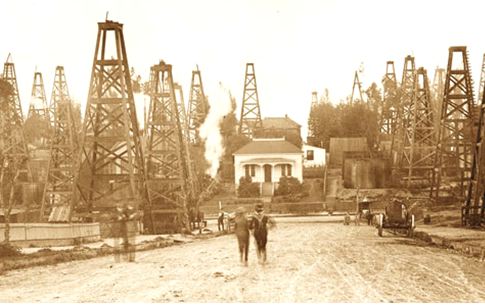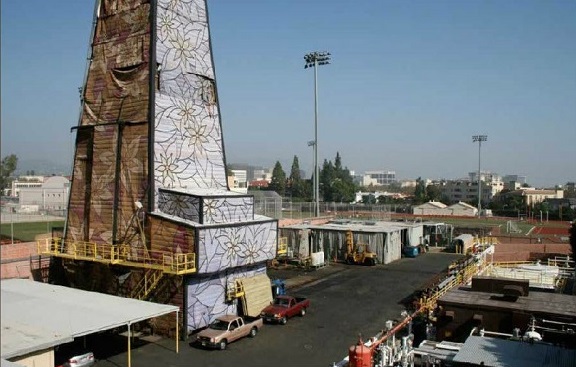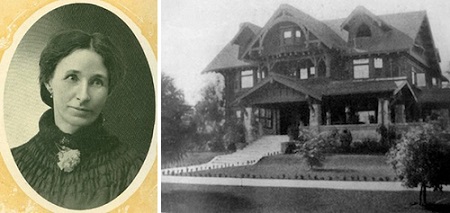The piano teacher who drilled wells — and took over the Los Angeles oil market.
“A woman with a genius for affairs – it may sound paradoxical, but the fact exists. If Mrs. Emma A. Summers were less than a genius she could not, as she does today, control the Los Angeles oil markets.” – July 21, 1901, San Francisco Call newspaper.
Emma A. McCutchen Summers would become a woman to be reckoned with in the early Los Angeles petroleum industry. A refined Southern lady who graduated from Boston’s New England Conservatory of Music, Summers moved to Los Angeles in 1893 to teach piano.

Emma Summers’ determination and business acumen put her in control of Los Angeles City oilfield production.
Like many others, Summers got caught up in the excitement of California’s petroleum industry. Pico Canyon, less than 35 miles north of Los Angeles, had produced limited amounts of oil as early as 1855.
A Humboldt County gusher in 1876 prompted more development, including an oil refinery for producing kerosene for lamps. Summers’ home was near where Edward Doheny discovered the giant Los Angeles City oilfield in 1892.
Oil Fever
Once a struggling prospector, Doheny made his oilfield discovery near tar seeps. He reportedly had noticed black stains on wagon wheels passing by (see Discovering the Los Angeles Oilfield).
Summers, who invested $700 for half interest in a well just a few blocks from Doheny’s headline-making producer, began drilling her own exploratory wells.
Her first Los Angeles well was drilled between Court and Temple Streets, about a mile west of today’s Dodger Stadium. It did not go well. The casing collapsed and tools were lost, but she persevered. Summers borrowed another $1,800 to continue drilling the well. “Night after night, by the light of a flaring torch, she hovered over it, as if it were a sick babe’s cradle,” reported one witness.
Weeks dragged on as the money dwindled, but the well finally came in. Encouraged, Summers drilled another well — and another, and another. “When I found myself $10,000 in debt, I thought if I ever got that paid and as much more in the bank, I would be glad to quit,” she later recalled. She didn’t quit.

The Los Angeles City oilfield at the turn of the century. Photo courtesy of the California History Room, California State Library, Sacramento.
Summers became a constant presence in the forest of oil rigs that had turned the heart of Los Angeles into a “vibrant, oil-soaked little canyon.” The population doubled between 1890 and 1900, and her oil business prospered.
Oil Queen
By 1901, Summers was operating fourteen paying wells of her own and leasing others to meet the market demand. “It has been like this with me always,” she recalled.
“I saw a chance in the oil business and sunk a well, and that carried me on and on until I couldn’t stop,” she added. Her wells produced 50,000 barrels each month. At first she sold her oil through local brokers but eventually took on that challenge in addition to managing her supplies, 40 horses, 10 wagons, and a blacksmith shop.

A derrick tower that moves on tracks can service 19 horizontal wells drilled under an adjacent neighborhood. Photo courtesy the Center for Land Use Interpretation.
As the exploration and production boom brought prosperity to Southern California, Summers marketed her petroleum to downtown hotels, factories, railroads, and the Pacific Light & Power Company.
“There are men in Los Angeles who do not like Emma A. Summers,” proclaimed the July 1911 issue of Sunset magazine. The former piano teacher had made enemies along the way to becoming known as the “Oil Queen” of California.
Summers expanded her holdings into real estate as World War I demand for petroleum increased her profits. She bought some of the first motion picture theaters in Los Angeles as well as apartment houses, several San Fernando Valley ranches, and a Wilshire Boulevard mansion.
As the Los Angeles City oil boom waned, Summers moved into her elegant hotel appropriately named the Queen. Years later she recalled, “Oh, how scared I was sometimes! I would start in on a big deal and then get scared and wonder where I’d land. But I usually came out all right.”
Summers lived out her last years at the Biltmore and Alexandria hotels. She died in a Glendale nursing home in 1941 at age 83. Her “genius for affairs” put Emma Summers in control of the Los Angeles City field’s production — and earned a piano teacher the title of California’s oil queen.
Often completely overlooked by those who pass by, downtown wells continue to produce oil (offshore wells, too). One well reportedly still pumps from the original 1892 Los Angeles City field.
The Center for Land Use Interpretation, based in Culver City, has visited many historic petroleum sites; many are featured in an online photo essay, Urban Crude: The Oil Fields of the Los Angeles Basin.
_______________________
Recommended Reading: Black Gold in California: The Story of California Petroleum Industry (2016); Los Angeles, California, Images of America
(2001); Anomalies: Pioneering Women in Petroleum Geology 1917-2017 (2017). Your Amazon purchase benefits the American Oil & Gas Historical Society. As an Amazon Associate, AOGHS earns a commission from qualifying purchases.
_______________________
The American Oil & Gas Historical Society (AOGHS) preserves U.S. petroleum history. Become an AOGHS annual supporting member and help maintain this energy education website and expand historical research. For more information, contact bawells@aoghs.org. Copyright © 2025 Bruce A. Wells.
Citation Information – Article Title: “Oil Queen of California.” Authors: B.A. Wells and K.L. Wells. Website Name: American Oil & Gas Historical Society. URL: https://aoghs.org/petroleum-pioneers/emma-summers-oil-queen/. Last Updated: November 23, 2025. Original Published Date: December 1, 2008.




